Lindbergh was kept on life support long enough for his father to arrive from Sweden to join Lindbergh's mother, who was already in the United States on a visit, to say goodbye and then make the final decision to donate his organs and end life support on November 12th. Lindbergh was just 26 years old.
Tuesday, May 24, 2016
1984-85 Philadelphia Flyers Pelle Lindbergh Jersey
Born on this date in 1959 in Stockholm, Sweden Per-Eric "Pelle" Lindbergh made his debut with Hammarby IF of Stockholm's junior team in 1975 and made his international debut for the Sweden National Team that same season in the European Junior Championships earning the silver medal as well as the award for Best Goaltender. A second season with Hammarby as well as a second European Junior Championship appearance followed in 1976-77, which resulted in a gold medal as well as a second Best Goaltender award at the 1977 EJC.
Lindbergh in goal for Hammarby. Note the
Flyers logos on his mask even then.
His first season with Hammarby IF in Sweden's Division 1 in 1977-78 was highlighted with four games played at the newly promoted World Junior Championships, backstopping Sweden to a silver medal. At the time, NHL players had begun appearing in the World Championships, beginning in 1976. International Ice Hockey Federation officials began to fear that true amateur and younger players were losing their places they traditionally held with teams at the World Championships, so the Under-20 Junior Championships were elevated to full world championship status in 1977.
A second season with Hammarby IF in Division 1 in 1978-79 saw him named Best Goaltender at the 1979 World Junior Championships, where Sweden would win the bronze medal, followed by making his debut with the Sweden National Team at the senior level at that year's World Championships in Moscow, helping Sweden to a bronze medal finish. He was also drafted by the Philadelphia Flyers 35th overall in the 1979 NHL Entry Draft and the second goaltender and second European taken that year.
1979-80 was a breakthrough season for the young netminder, as he would take over the starting role in goal for AIK Stockholm in the Elitserien, Sweden's highest professional level, appearing in 32 games and being named to the 1980 Swedish Olympic Team. Lindbergh would appear in five of Sweden's seven games as Sweden won the bronze medal.
He would make his NHL debut with the Maine Mariners of the American Hockey League in 1980-81, winning the Hap Homes Award, the Les Cunningham Rookie of the Year Award and the Red Garrett Most Valuable Player Award honors after a stellar 31-14-5 record in the regular season and a 10-7 mark in the playoffs as Maine reached the Calder Cup Finals.
Prior to the next season, Lindbergh was named to the Sweden National Team's roster for the 1981 Canada Cup tournament. He would split time in 1981-82 between the Mariners (25 games) and make his NHL debut with the Flyers with eight games, posting a 2-4-2 record.
The departure of Pete Peeters for the Boston Bruins opened up more time for Lindbergh in 1982-83, as he became the number one goaltender for the Flyers, appearing in 40 games, posting a 23-13-3 record and was named to the NHL All-Rookie Team and played in his first NHL All-Star Game. Following the NHL season Lindbergh played in his second World Championships for Sweden and yet another medal, this time a bronze, his seventh international medal.
Lindbergh at his first NHL All-Star Game in 1983.
Bob Froese took the majority of the starts in Philadelphia in 1983-84 with 48 games played, with Lindbergh finishing with a 16-13-3 mark in 36 appearances.
The high point of Lindbergh's career came in the 1984-85 season, when Lindbergh saw the bulk of the workload, seeing action in 65 games while going 40-17-7 to lead the league in wins and help the Flyers reach the Stanley Cup Finals. His outstanding play was rewarded with his second NHL All-Star Game appearance as well as being named the recipient of the 1985 Vezina Trophy, the first European goaltender in NHL history to ever win the award.
Lindbergh with the Vezina Trophy.
Lindbergh also became the first goaltender to bring a water bottle with him on the ice during a game to combat severe dehydration that plagued him, a now accepted and regular practice.
In addition, Lindbergh was also known for his stark white goalie mask used during a period when nearly all goalie masks were adorned with increasingly elaborate paint schemes to reflect either the team's identity or their individual personality. The mask was a replica of his idol and goaltending coach, former Flyer goalie Bernie Parent.
Lindbergh facing The Great One, Wayne Gretzky
Following his Vezina Trophy winning season, Lindbergh signed a six year contract with the Flyers and bought himself a 565 horsepower, customized Porsche 930 Turbo. He began the 1985-86 season in good form, winning six of his first eight starts, but tragedy struck when Lindbergh crashed his car while driving impaired on November 10, 1985, leaving him brain-dead and his two passengers seriously injured.
Lindbergh was kept on life support long enough for his father to arrive from Sweden to join Lindbergh's mother, who was already in the United States on a visit, to say goodbye and then make the final decision to donate his organs and end life support on November 12th. Lindbergh was just 26 years old.
Lindbergh was kept on life support long enough for his father to arrive from Sweden to join Lindbergh's mother, who was already in the United States on a visit, to say goodbye and then make the final decision to donate his organs and end life support on November 12th. Lindbergh was just 26 years old.
His death stunned is teammates, the city of Philadelphia and the nation of Sweden. Fans then made Lindbergh the top vote getter for the 1986 NHL All-Star Game, the first time a player was chosen posthumously for an all-team in North American sports.
While Lindbergh's #31 was never officially retired, no Flyer has worn the number since.
The Flyers created the Pelle Lindbergh Memorial Award in 1994, given annually to the Most Improved Player each season.
For more on the life and career of Pelle Lindbergh, we recommend Pelle Lindbergh: Behind the White Mask .
.
Today's featured jersey is a 1984-85 Philadelphia Flyers Pelle Lindbergh jersey from the season he recorded his career high 40 wins. The Flyers adopted this modernized version of their classic jersey in 1982-83, Lindbergh's second season with Philadelphia. It featured the addition of more black trim to separate the orange arm coloring from the white of the body and was made by Sandow SK. The following season the jersey remained the same, but was now made by CCM. One season later the Flyers jerseys again were rebranded, this time by Eagle.
This style Flyers jersey was essentially carved in stone, as it remained unchanged through the 2006-07 season after which it was replaced by the Reebok Edge jersey, sadly doing in an iconic jersey after 20 years of service.
Bonus jersey: Today's bonus jersey is a 1979 Sweden National Team Pelle Lindbergh jersey as worn in the 1979 World Junior Tournament which took place in Sweden. Lindbergh was named the Best Goaltender and helped Sweden earn a bronze medal that year.
This jersey is from a period of time in the late 70's/early 80's when Sweden moved away from their traditional three crowns logo and instead sports the phrase "Tre Kronor", which translates to "Three Crowns".
photo courtesy of Classic Auctions
While there are numerous Lindbergh game highlights, news reports and tributes available, we chose to feature this excellent tribute today.
Labels:
Lindbergh Pelle,
Philadelphia Flyers,
Sweden
Subscribe to:
Post Comments (Atom)


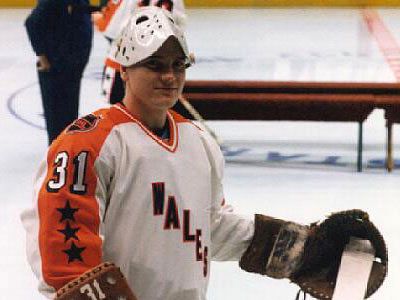
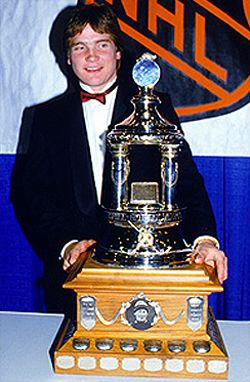
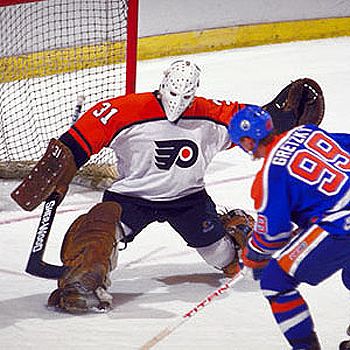
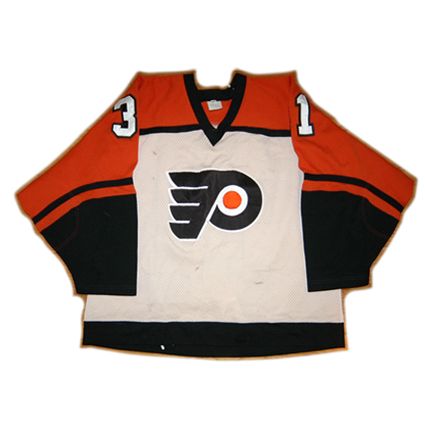

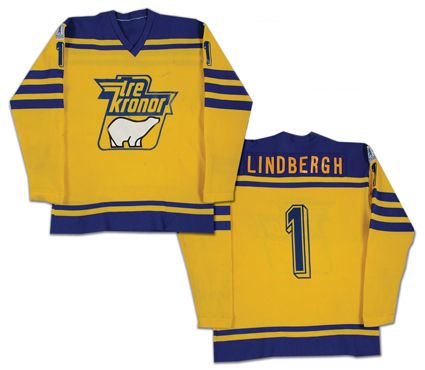










No comments:
Post a Comment
We welcome and encourage genuine comments and corrections from our readers. Please no spam. It will not be approved and never seen.